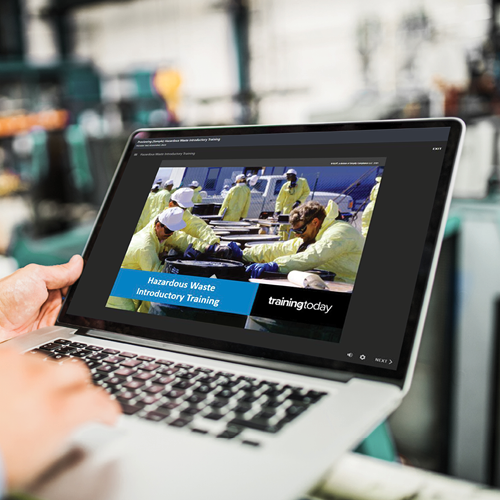Environmental Compliance Protect your operations with environmental compliance training
Online environmental compliance courses to meet federal, state, and industry requirements.
Get startedMeet complex regulations with confidence
Building a culture of environmental responsibility begins with education. TrainingToday’s interactive EHS compliance courses go beyond regulatory checkboxes, connecting compliance to your organization’s broader goals of safety, environmental care, and operational excellence. Each course delivers expert-developed guidance that helps your teams confidently navigate environmental management, reporting, and best practices.
Download Course CatalogEPA and state regulatory compliance training
Our expert-built EHS content equips your employees with the information and know-how needed to stay current and compliant with today’s industry standards.

Environmental planning and prevention courses
Strong environmental programs start with awareness and preparation. TrainingToday’s environmental health and safety training gives your employees the tools and insight to identify potential environmental impacts and implement preventative measures that benefit your business and the planet.
-
Risk management training
TrainingToday’s courses help employees recognize process hazards and implement safeguards that protect your operations and community. Your team will learn what a risk management program is, how to identify the dangers associated with processes utilizing toxic and flammable substances, and what to do to prevent accidental chemical releases at your facility.
-
Stormwater pollution prevention courses
Teach your team how to reduce pollutants in stormwater runoff through responsible site management. These lessons promote clean water initiatives and help meet EPA and state-specific requirements.
-
SPCC and FRP training
Our SPCC courses provide your workforce with the knowledge to prevent spills and respond effectively when they occur. Courses align with SPCC and federal response plan guidelines to protect natural resources and maintain compliance.
-
Environmental inspections training
Our environmental inspections courses empower employees to approach inspections with confidence. Courses outline best practices for documentation, communication, and corrective action planning to demonstrate environmental diligence.

Hazardous waste management courses
Proper waste management protects both people and the planet. TrainingToday’s environmental compliance training courses simplify complex EPA and RCRA requirements, helping your workforce handle, store, and dispose of hazardous materials safely and efficiently.
-
HAZWOPER training
TrainingToday’s HAZWOPER courses ensure employees are prepared for cleanup and emergency response operations. Our expert-led content supports EPA and OSHA compliance training while emphasizing safety and environmental protection.
-
Container management training
Learn proven methods for labeling, storing, and monitoring hazardous waste containers to prevent leaks, contamination, and regulatory issues.
-
Recordkeeping and reporting courses
Teach your team how to maintain accurate, audit-ready records that demonstrate your organization’s commitment to environmental responsibility and compliance.

Hazardous materials handling and transportation training
Safe handling of chemicals and materials supports a healthier workplace and a cleaner environment. TrainingToday’s compliance training helps your employees understand and follow federal and state requirements with confidence.
-
HAZCOM courses
Help employees recognize and communicate chemical hazards effectively. Training covers OSHA’s Hazard Communication Standard, labeling requirements, and Safety Data Sheet (SDS) interpretation.
-
Hazmat transportation training
Equip your teams to transport hazardous materials safely and responsibly. These courses cover DOT regulations and best practices to ensure secure, compliant transit.
-
Chemical handling procedures
Foster awareness and care when using, transferring, or storing chemicals. Employees learn how proper handling reduces exposure, prevents spills, and protects the environment.
Support your compliance training goals
With TrainingToday’s environmental compliance training, organizations can create stronger environmental programs that drive both compliance and sustainability. Our continually updated EHS compliance courses are built by experts to reflect current EPA, OSHA, and state requirements, helping your team stay confident, capable, and compliant.


